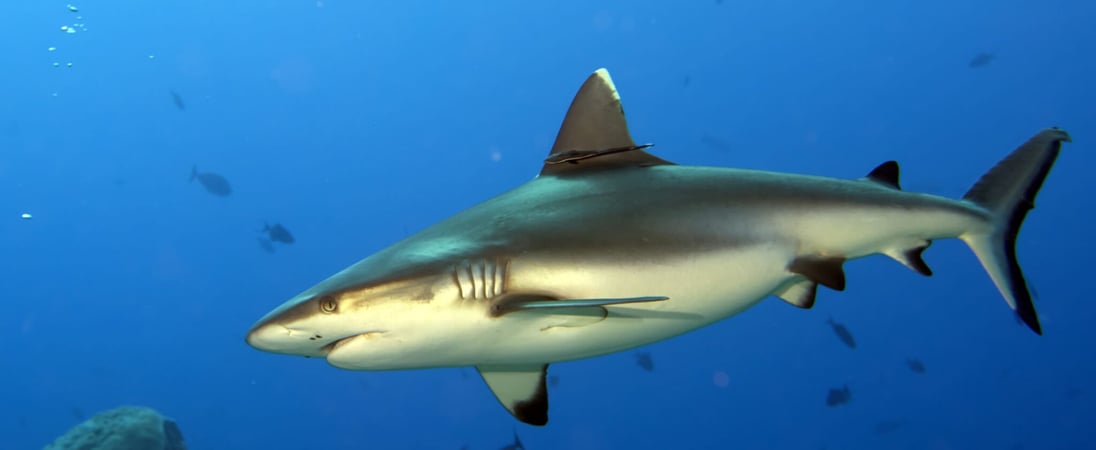
Shark Awareness Day
Tackle the stigma and raise awareness about the reality of sharks, which are beautiful creatures that keep the ocean ecosystem running and rarely attack humans.
Contrary to what you might expect, the purpose of Shark Awareness Day is not to stand on the beach and shout out warnings to terrified swimmers and surfers, despite the hours of mischievous fun that could provide!
Like top predators in any ecosystem, sharks play an essential role in keeping the seas healthy and productive, and yet various threats make these ocean oligarchs a persecuted and vulnerable species.
While no one is suggesting we go out and hug a great white on Shark Awareness Day, it’s the least we can do to respect these wonderful creatures and help protect them.
How to Celebrate Shark Awareness Day
There are loads of fin-tastic ways to get stuck into Shark Awareness Day…
As the event is all about tackling stigma and increasing awareness, one of the best ways to celebrate is to find out more about these seas (and occasionally river) dwellers.
Check out the multitude of online resources available from websites such as the Shark Research Institute or Shark Trust, head on over to your local library to borrow books like The Secret Life of Sharks or Sharks of the World, and see what documentaries are available in your country, for example, Sharkwater or Of Shark And Man.
And be sure to share what you’ve learned far and wide to help dispel fears about these deeply misunderstood animals.
You can also do your bit to help protect sharks. Try to avoid shark products wherever you can – something like shark-fin soup is pretty obvious, but many beauty products such as soap and makeup include squalene, which comes from shark livers, and leather items such as bags and belts could be made from shark skin, known as shagreen.
More generally, try to reduce your seafood consumption or ensure that it is sustainably and safely sourced to help combat overfishing and bycatch.
And if you’re really serious about sharks, then why not take action to protest shark finning or unnecessary culling? Sign a petition, write a letter, organize an event or donate to a non-profit dedicated to shark conservation such as Shark Savers and the Shark Alliance.
A Short Summary of Sharks
From the mako to the basking, from the great white to the hammerhead, from the nurse to the tiger, sharks roam our oceans (and in a couple of cases our freshwater rivers) the world over.
These toothy fish, which are closely related to rays, live for around 30 years on average, but some species make it to over 100, with one Greenland shark discovered to be at least 272!
Their most distinctive feature is of course their razor-sharp teeth – sharks can have as many as seven rows of gnashers and go through up to 30,000 of them in their lifetimes.
Another key weapon in their hunting arsenal is their electrical sensitivity, able to pick up on electromagnetic fields better than any other animal. This allows them to seek out their prey, even if hiding or camouflaged.
With so many species found all over the globe, it’s no wonder that these water-dwellers also possess a few weird and wonderful quirks!
Did you know, for example, that bamboo sharks can’t actually swim (instead they push themselves along the sand with their fins) or that frilled sharks’ pregnancies last a lengthy 3.5 years?
Did you know that hammerheads have a 360-degree vision or that female sharks will occasionally reproduce via parthenogenesis (essentially a type of cloning)? It’s nothing short of enthralling whenever it comes to sharks!
History of Shark Awareness Day
Sharks are one of the oldest species on the planet, with fossil records showing they were cruising our oceans at least 420 million years ago.
Modern-day sharks have been around for about 100 million years – even that’s back when the dinosaurs existed!
Nowadays there are over 500 species of shark, ranging from the tiny dwarf lantern shark, able to fit into the palm of your hand, to the gigantic whale shark, which can clock in at up to 10m.
However, this is nothing compared to the megalodon, a now extinct relation of the modern-day great white, which may have reached sizes of a whopping 20m!
Some cultures, such as Hawaiian and Pacific Island cultures, have long revered and respected these impressive hunters and predators, with various legendary tales and mythologies.
Unfortunately, however, cultural depictions of these creatures have by and large been a significant contributing factor to the fear and stigma surrounding them.
You’re hard-pressed to find a shark film that doesn’t portray these animals in at least a partially negative light, and the majority of Hollywood blockbusters, from Jaws and Deep Blue Sea to The Shallows and 47 Meters Down, have perpetuated the idea of sharks as bloodthirsty, vengeful monsters.
Those familiar with sharks will know that this unfair reputation is far from the truth, and the sad fact remains that these magnificent creatures are threatened far more by us humans than we are by them.
In fact, while there are around 10 fatal shark attacks a year (for context, cows kill 20 people a year, ants kill 50 and falling coconuts kill 150!), the various dangers they face all combine to mean an estimated 100 million sharks are killed by humans each year.
These include overfishing and bycatch (through which their food source is depleted and they’re often killed as collateral damage in the fishing process), pollution, the worldwide demand for commodities such as shark-fin soup and shark-tooth medallions, and an inflated sense of threat at beaches and other coastal regions where sharks are known to swim the waters, leading to excessive culls.
Shark finning in particular is an especially cruel and wasteful practice, in which just the fins are taken for food and the live animals thrown back into the sea where they will soon drown or be eaten by another predator.
As a result of these activities, experts believe that over the past 50 years shark numbers have declined by more than 70%, a devastating loss to the biodiversity of our oceans. And that’s why Shark Awareness Day is so important, helping to preserve these vital fish now and well into the future.
Shark Awareness Day aims to both dispel the fear, stigma, and misinformation surrounding sharks and also raise awareness of this creature’s plight, inspiring people all over the world to take action in their defense.
Why Sharks Are So Significant
The vulnerable status of these feisty fish, with many species classed as threatened and some even as critically endangered by the International Union for Conservation of Nature (IUCN), has serious implications that go far beyond just the sharks themselves.
As top predators, sharks are vitally important for healthy ecosystems, preventing the populations of other animals from getting too large and often preying on the old and sick, which helps keep the remaining populations in good shape.
This also has knock-on effects for wider oceanic and planetary conditions. For example, by keeping sea turtle numbers in check, sharks also help maintain seagrass levels, which are an important carbon sink. A balanced ocean ecosystem means a healthy planet, and sharks are essential to maintaining that balance.
Shark Awareness Day FAQs
How did ancient sailors view sharks as omens?
Many sailors believed sharks were harbingers of death. Stories suggested sharks followed ships to feed on souls lost at sea.
These tales, passed through generations, painted sharks as mysterious creatures with supernatural abilities.
Why do sharks sometimes appear to ‘spy hop’?
Some sharks, like the great white, lift their heads above water, a behavior called “spy hopping.”
This lets them survey the environment, often to locate prey or inspect objects. This behavior shows how curious and adaptive sharks can be.
What are ‘mermaid’s purses,’ and how are they linked to sharks?
‘Mermaid’s purses’ are egg cases from certain shark species like catsharks.
These tough pouches protect embryos as they develop. Beachcombers often find them washed ashore, sparking curiosity about shark reproduction.
How do sharks use bioluminescence?
Some sharks, like the lantern shark, use bioluminescence to glow in the dark.
This adaptation helps them blend into sunlight filtering from above, hiding them from predators below. It’s a fascinating survival mechanism.
What role do sharks play in keeping coral reefs healthy?
Sharks regulate fish populations, preventing overgrazing on coral reefs. Without sharks, algae could overwhelm coral ecosystems. Their presence ensures the balance essential for reef biodiversity.
Are sharks really the ‘villains’ of the sea?
Hollywood often portrays sharks as vicious man-eaters, but most species avoid humans.
Shark attacks are rare and often cases of mistaken identity. Misconceptions fuel fear, overshadowing their ecological importance.
What are the oldest shark fossils ever found?
Shark fossils date back over 400 million years, long before dinosaurs. Their ancient ancestors, like the Cladoselache, had simpler body structures but were effective predators. Sharks are evolutionary marvels.
Why do sharks shed and regrow teeth so often?
Sharks lose thousands of teeth over their lifetimes. New teeth grow in conveyor-belt fashion, replacing lost ones. This adaptation ensures they remain effective hunters, even after losing teeth.
What’s unique about shark sleep?
Sharks don’t sleep like humans. Some species must swim constantly to breathe, entering rest-like states while moving. This dual-function behavior highlights their unique biology.
How do sharks inspire art and culture?
Sharks feature in ancient Polynesian tattoos as symbols of strength and protection.
Modern art often depicts them as misunderstood creatures, blending fear with admiration. They leave a powerful impression in human creativity.
See what else is happening…
There’s always more going on every month at Days Of The Year. Here are our favorites this month!
Also on ...
View all holidaysNational Mac & Cheese Day
Diving into a warm, comforting bowl of cheesy goodness, each forkful a delightful blend of creamy and savory delight.
World Chimpanzee Day
Explore the intricate lives of our primate relatives, witnessing their intelligence, social bonds, and fascinating behaviors in the wild.
National Grand Marnier Day
An innovative liquor, Grand Marnier goes well with many things. Mix it together with champagne, or make a Grand Marnier-based margarita with tequila.
International Non-Binary People’s Day
Non-binary identities challenge traditional gender norms, fostering inclusivity and understanding in diverse communities worldwide.




